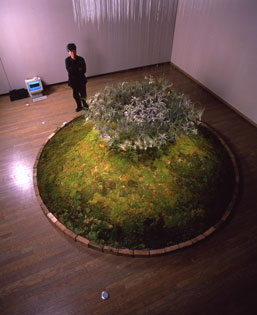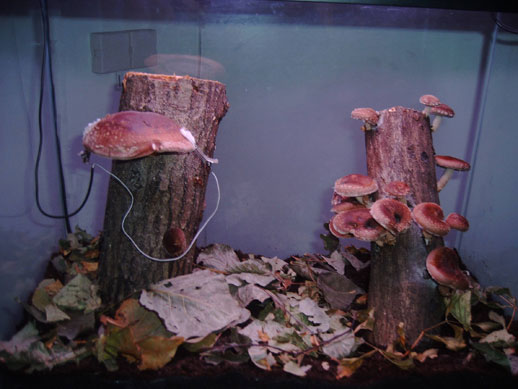Silent Dialogue or Silent Cries?
It has been 105 years since Thomas Edison filmed his experimental electrocution of Topsy the elephant, and yet we still seem content to display science as art. Topsy was the perfect vessel for Edison to showcase his amazing invention and although his silent film masks the pain felt by the animal, the image does not. Today, it’s available to watch on youtube but why on earth would you want to? Surely we cannot derive interest from experimenting on a living creature and justify it by putting it in a gallery space?

The same curiosity that might encourage you to watch Topsy’s demise might also prompt you to visit NTT ICC’s exhibition, aptly titled “Silent Dialogue”. There are no animals being tortured here. Instead, the organizers and participating artists have focused on the environment and turned their scientific eyes toward the invisible communication between animals, plant life and vegetation. So what can we expect from such a show? Expect sensors, monitors, computers, headphones, and the usual paraphernalia that tends to accompany these kind of interactive exhibitions. Also, expect to see signs for things you can and can’t touch as well as the inevitable system crashes and program failures that tend to embarrass and plague interactive works such as these (one work had to be reset whilst I was there). If you have any questions about the works (and no doubt you will) expect the gallery staff to explain away all the secrets of how the works actually interact with viewers. This is perhaps the exhibition’s most interesting point in that the works themselves are reacting to you within the given environment rather than you interacting with them. There is a sense of insignificance placed on the viewer through this reversal of roles yet such a submission would never last long in this society. Step back and the space takes on the feel of a high school science experiment with no teachers to supervise proceedings. In other words, its becomes less educational and rather more sadistic.
Although there are works by 8 artists and collaborations on display, the works produced by the botanist Yuji Dogane’s collaborations chiefly symbolize this sadism. His piece titled Paphio in my life (2007) produced in collaboration with the composer Mamoru Fujieda, confronts us with four tables, each filled with various household plants and flowers. Attached to particular plants are wires leading to a program, which translates the plants’ ‘feelings’ into a linear graph on a monitor on the far wall. These visualizations are said to embody the inaudible conversations taking place between the various plant-life. As viewers walk around the tables, the flowers are said to communicate more. The problem for me here is the obviousness of this work’s claim. I can understand the justification in using this technology to remind us that plants and animals communicate as much as we do but isn’t it a little insulting to the viewer’s natural instincts? The exhibition preface states that “Plants and animals form closed systems” but does that mean we are above that system looking into theirs or are we a part of their system and should respect it accordingly? If we accept the fact that plants talk, then we can only assume that they had a lot to talk about what with all the visitors walking around them. Then again, if a group of foreign visitors were placed on a table in a dimmed white gallery space, would we keep quiet about it?

My point is that the exhibition fulfills a brief in that it visualizes voices that we cannot hear as well as reminds us of our tendencies to ignore the feelings of their closed system. This is practical and informative but is it art? Being placed in the one space with little soundproofing between works, one could say that the works were cross fertilizing each other, adding extra elements and taking others away and thus creating their own closed system. However, one could also say that the various hums, shrills, clicks and tweaks rang through the space like that of a torture chamber. This exhibition unfortunately felt like a laboratory first and a gallery second, with neither environment being natural to the subjects held captive inside it. No wonder then, that the plants were so vocal.
For Topsy the elephant, her scream will remain forever silenced by the spectacle of film. For these plants and flowers cooped-up and evidently dying in this space, their cries are masked by the hybrid quasi-scientific pseudo artistic visualizations of these artists. The venue is fitting for such a collaboration between science and art and the show promises to ask such profound questions as ‘What do we know?’ and ‘What can we learn?’ Sadly, it only questions the frequently visited border between art and science, leaving us questioning the necessity for art in the first place.
Gary McLeod
Gary McLeod


